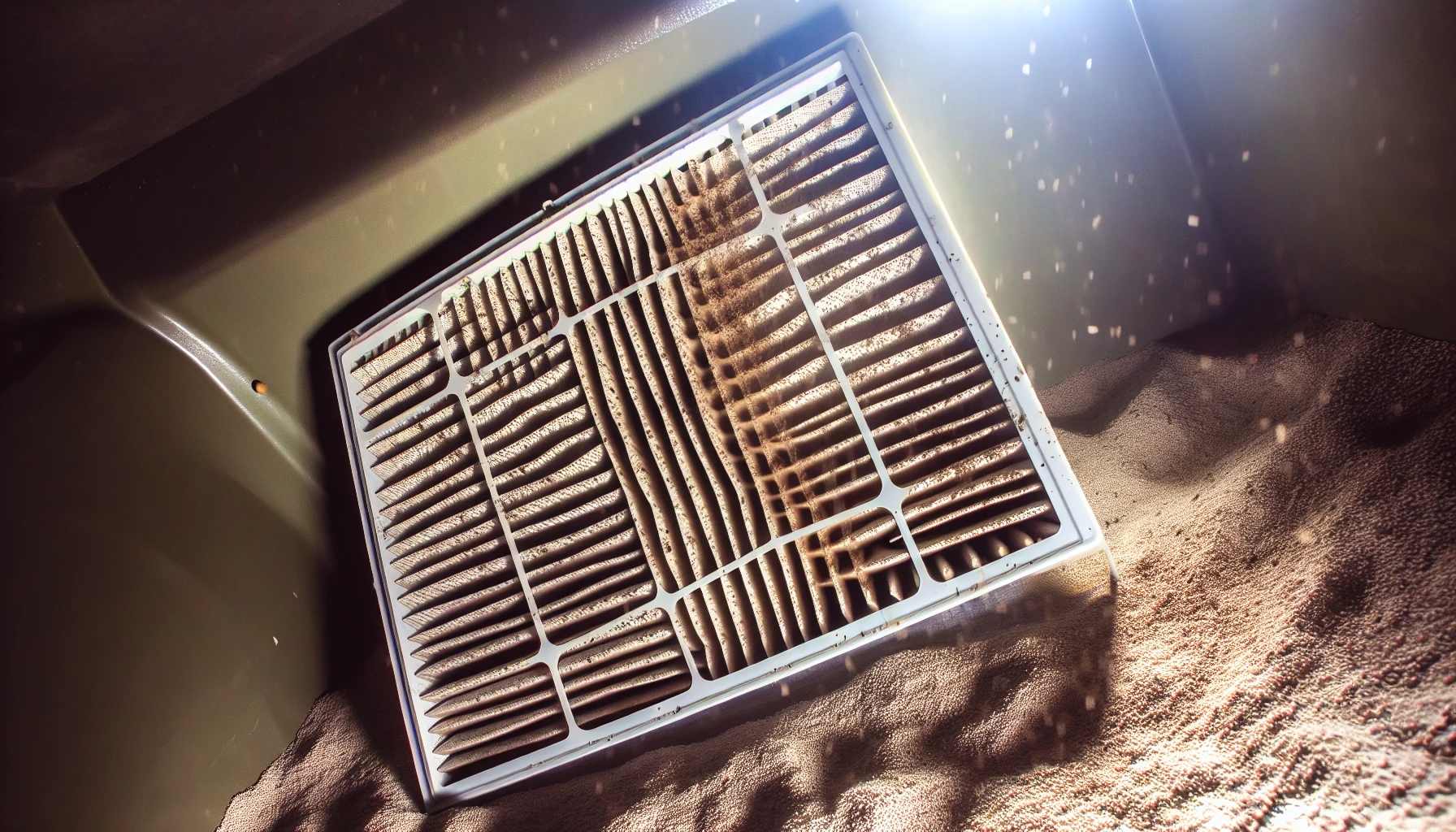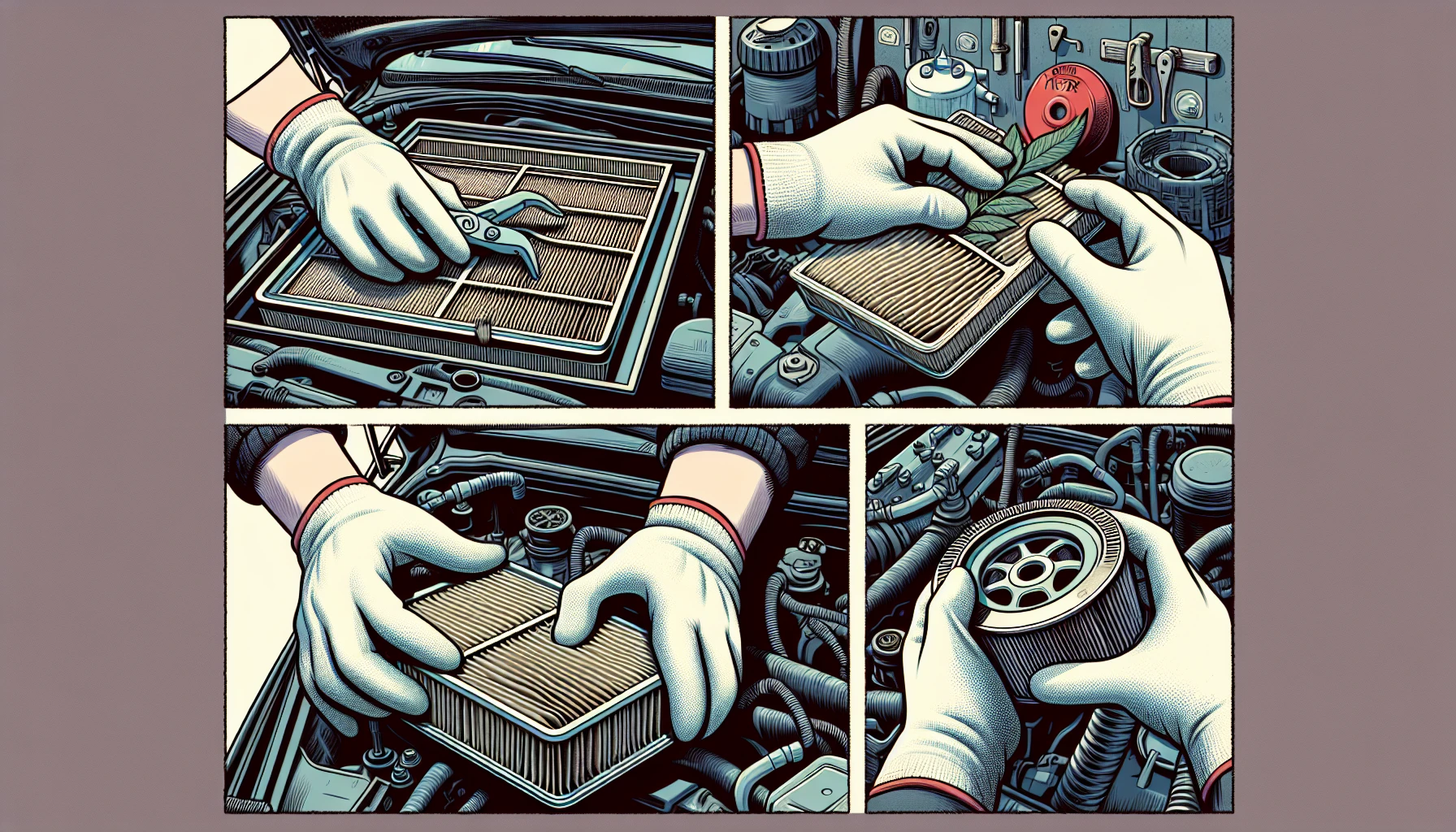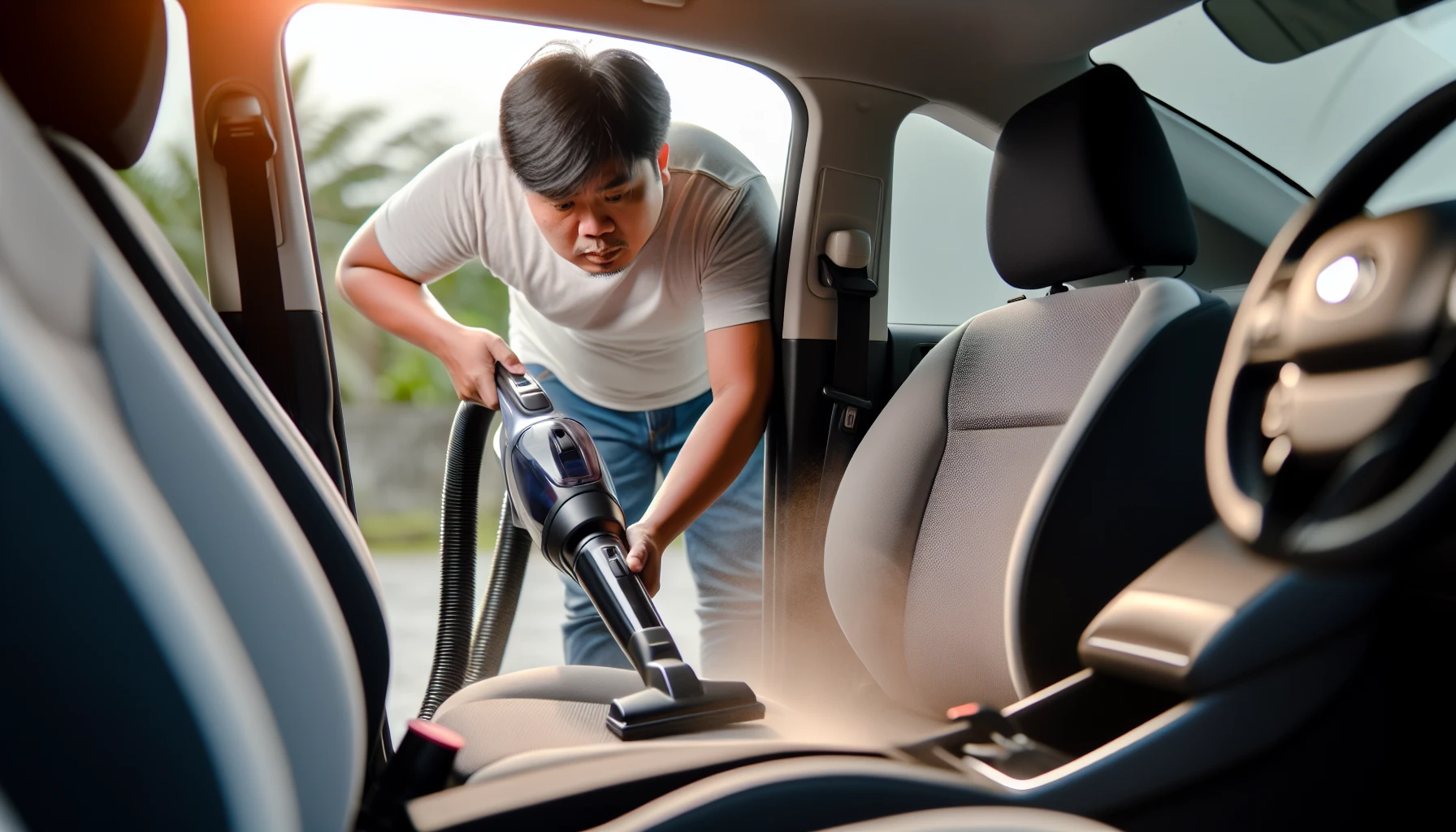Do you suffer from coughing or sneezing caused by air in the car that is filled with dust? If so, it’s time to bring freshness back and start breathing cleaner air again, replace your cabin filter! This guide will tell you how essential these filters are for healthy indoor environment, when exactly they should be replaced, and offer a step-by-step instruction on what needs to be done.
Key Takeaways
-
Regularly replacing cabin air filters is essential for protecting passengers from airborne contaminants and maintaining HVAC efficiency.
-
Selecting the right filter requires research of factors such as type, compatibility, filtration efficiency, material quality & additional features.
-
Ensure optimal air quality in your vehicle through regular cleaning/vacuuming, odor/bacteria management & ventilation/air circulation optimization.
Understanding the Importance of Cabin Air Filters

Cabin air filters are essential for maintaining a pleasant atmosphere in your car. They capture pollutions, allergens and dust particles from the cabin air intake ducts before they get into the system of heating, ventilation and air conditioning (HVAC). This way passengers experience cleaner breathable environment while driving.
Failing to replace these filters can cause significant problems such as decrease airflow rate inside cabin, noxious odors or premature failure of HVAC parts. Consequently replacing them on time not only maintains good passenger health but also assures robustness of fan blower motor by capturing contaminants before entering vehicle’s interior area via cabin air filters’ barrier function.
Difference Between Cabin Air Filter and Engine Air Filter
The correct upkeep of both cabin and engine air filters is essential for an enjoyable driving experience as well as maintaining the health of your vehicle. Cabin air filtration defends passengers from dust, pollutants, and other particulates when running their car’s AC system while a motorized filter works to prevent dirt particles or debris from infiltrating into the internal components which can cause damage. Both are important parts of any automobile in ensuring quality performance out on the road.
Not only do these filters keep contaminants away, but they also supply clean breathing atmosphere inside so you don’t have to worry about inhaling anything harmful during your travels!
How Cabin Air Filters Work
Cabin air filters are designed to capture dust and other contaminants, purify the cabin air breathed by you and your passengers, while protecting HVAC components. These types of filters typically consist of paper-based materials along with fibrous material or non-woven fabric that can collect dirt particles as well as pollen, mold spores and harmful pollutants from being spread throughout the vehicle. It is important to regularly replace these filters in order for them to continue performing their job effectively, which would guarantee clean fresh air inside your car without any potential health hazards caused by airborne pollutants drifting through it. By doing this consistently one will ensure a safe travel environment filled with pure breathable cabin air free from debris and dirty filter particles allowing all passengers on board to enjoy an enjoyable ride each time they get into a vehicle provided its outfitted with filters running at optimal capacity!
Benefits of a Clean Cabin Air Filter
The benefits of keeping your cabin air filter clean are immense, ranging from improved air quality for you and the passengers inside to boosted HVAC efficiency. Such a filter will block out pollutants, dust particles, and other matters that may taint the atmosphere within the car or vehicle. Better airflow due to a clear form allows less stress on both its engine’s performance and cooling effectiveness- something worth ensuring if one wants to avoid expensive repairs in their future. Finally, it helps keep everything looking nice with an untarnished interior design since all those elements can be filtered before they enter into such spaces!
Identifying When to Replace Your Cabin Air Filter

It is imperative to adhere to your vehicle manufacturer’s guidelines on replacing the cabin air filter in order for it to stay at optimal efficiency and provide a clean environment within. Look out for signs of blocked filters like reduced airflow, loud fan noise or increased dust. These could be an indication that you should replace your cabin air filter. Poor driving conditions (like travelling through dirt roads) may also reduce its lifespan, Necessitating frequent replacements. Maintaining a steady regimen when changing this important part keeps good quality internal air circulating inside the car so as not disrupt day-to-day performance.
Common Symptoms of a Clogged Filter
If you notice that the air circulation in your vehicle is not functioning properly, if there are bad odors or decreased heating/cooling performance, then it might be time to change out your cabin air filter. A dirty filter may cause an irritating whistling noise from the vents and could worsen allergies due to built-up dust particles and allergens. Allergies can get worse with clogged filters as well as asthma symptoms for some individuals. Ensuring good quality of air within one’s car by replacing this filtration system often will create a healthy atmosphere both for those driving and for those driving. To any passengers they have onboard their vehicle at all times.
Manufacturer's Recommendations
Ensuring your vehicle’s cabin air filter is changed at the manufacturer recommended intervals can have a significant impact on both performance and air quality. In most cases, it is advisable to switch out the filter every 12-18 months or after driving between 12,000 - 15,000 miles. This will vary depending on local conditions such as dirt roads that increase pollution levels which lead to a quicker buildup of debris in an airstream system. To find what works best for you always consult with your car’s manual regarding suitable replacement times for filters.
Impact of Driving Conditions on Filter Lifespan
A replacement cabin air filter is an important part to maintain the best possible quality of air within your vehicle. Driving in congested areas or through dusty environments can have ten its clogging with dirt and other pollutants, which diminishes the filtration effectiveness. To maximize performance, manufacturers recommend following their instructions on replacement intervals for cabin air filters so that you can be sure you are getting a steady supply of clean air inside your car’s interior.
Selecting the Right Cabin Air Filter for Your Vehicle
When selecting a cabin air filter for your vehicle, look into the types of filters available, their compatibility with the car’s system, and if there are premium or standard options. Ensuring that the air entering your auto’s interior is free from harmful pollutants can make driving more comfortable for you as well as those in it.
To ensure optimal filtration efficiency and better quality material to purify the passengers’ environment, be sure to evaluate different kinds of cabin air filters including odor neutralization abilities they may have on offer. Investing in a high-grade one could prevent HVAC damage while also providing cleaner and safer breathable air inside your motorcar’s interior cabinspace too!
Types of Cabin Air Filters
Cabin air filters come in different types and are constructed to eliminate airborne particles, such as those ranging from 5-100 microns. For example, particulate cabin air filters can filter out up to 90%-99% of these pollutants coming into your vehicle’s interior space. Activated carbon cabin air filters use an array of activated charcoal to capture gaseous impurities like VOCs (Volatile Organic Compounds) while also eliminating bad odors that may enter the car’s cab area. This type is especially beneficial for individuals who suffer allergies or have a sensitivity to particular chemicals since it reduces exposure to irritants drastically.
Compatibility with Your Vehicle
It’s essential to make sure the cabin air filter you buy is compatible with your vehicle’s model and type. To determine if a particular cabin air filter fits, check out the manufacturer’s owner manual for exact part numbers that fit well. Alternatively, look into an automotive parts shop online or visit the producer website in order to search up appropriate filters using relevant information about your car. Doing this will guarantee efficient operation of HVAC systems resulting in clean air flow for all people inside, including passengers!
Premium vs. Standard Options
Cabin air filters are available in both standard and premium options, with the latter often including features such as odor neutralization and superior filtration. These higher quality materials can trap small particles like dust, pollen, allergens, etc., improving your vehicle’s interior air quality considerably. Despite costing more than regular models though, a premium cabin filter might be worth considering if you have sensitivities to specific pollutants or other airborne substances. Weighing up costs versus benefits is important when making this decision, look into what type of filter best suits your needs before investing in one for your car!
Step-by-Step Guide to Replacing Your Cabin Air Filter

In just a few simple steps, you can increase the air quality within your vehicle and make sure that its HVAC system works optimally by changing the cabin air filter. Here is an easy guide for replacing it so that both you and your passengers have a pleasant experience when driving.
To get started, grab whatever tools are necessary to remove the old filter – this process should be quick with minimal preparation required! Once you’ve removed it from its compartment in your car’s cabin area, pop in a new one and enjoy fresh filtered air circulating throughout while on-the-go!
Preparing Your Workspace
Before taking your car to a repair shop, it is possible to replace the cabin air filter with some of these tools: flashlight, Torx head screwdriver, set of screwdrivers and socket set (safety glasses are also advised). Cover the passenger side floor mat before starting so that any particles or debris will not be spread when replacing. Ensure there’s plenty of light in order for an easier installation process. Remove anything obstructing you from being able to access components related to this part.
Accessing the Cabin Air Filter
For access to the cabin air filter, emptying and dismounting the glove box is typically required. To take it off, press on both sides until you hear a ‘pop’. In some cases, disconnection may be easier for full accessibility of this component.
Once that step has been completed, locate where behind it sits the housing for your filter, remember its orientation and follow directional airflow instructions which are indicated thereon.
Proper Installation Techniques
Before installing the cabin air filter, make sure that it is set to match the airflow direction according to arrows on its surface. Clean out any dust and debris by vacuuming in order for everything to be ready for installation. Then place securely into position before replacing contents of glove box back again. The result will be a much fresher atmosphere inside your vehicle! Enjoy cleaner air with this new cabin filter successfully installed!
Tips for Maintaining Optimal Air Quality in Your Vehicle

Having a clean, pleasant atmosphere in your vehicle is essential for both you and your passengers’ comfort. To guarantee the air quality of the car stays high at all times, it’s important to practice regular cleaning routines as well as make sure good ventilation and air circulation exist. Here are some useful tips that can help maintain healthy inside-air conditions.
-
Make use of deodorizers or bacteria eliminators. This will control any odors present in the car’s interior space while also eliminating potentially hazardous microorganisms from living within its confines.
-
Clean often with an appropriate product so dust doesn’t accumulate over time thus keeping allergies away from yourself and others who enter into your vehicle later on down the road.. Ensure optimal levels of airflow throughout by opening windows regularly to let fresh outside breeze flow freely.
Regular Cleaning and Vacuuming
Regularly cleaning and vacuuming your vehicle can help maintain the air quality inside, creating a healthier atmosphere for you and any passengers. Focus on interior surfaces like seats, carpets, floor mats, as well as hard-to-access crevices that tend to collect dust and allergens. Cleaning vents is important too. Doing so helps remove particles such as bacteria which could compromise overall air condition in your car. Taking these steps will not only create a much cleaner environment, but also reduce the chances of experiencing irritation due to airborne pollutants while traveling or riding with others in your automobile.
Managing Odors and Bacteria
To combat bad smells and germs in the car, one may employ air fresheners or deodorizers. These items will not eradicate bacteria, but can reduce odors and improve the atmosphere for vehicle’s occupants. It is advised to select fragrances that lack any abrasive chemicals so as to create a more wholesome environment while inside your automobile. The recommended frequency of replacing scent is every 1-2 months based on user preference and type of aroma used.
Ventilation and Air Circulation
For an ideal air quality in the car, it is important to provide ventilation and proper circulation. Using your vehicle’s HVAC system, including AC, ventilator and heater, can help keep circulating fresh air while minimizing the buildup of allergens or pollutants inside the cabin. Opening windows occasionally or setting recirculation on may also be beneficial for not letting contaminated outdoors into your automobile’s atmosphere. Thus, by managing adequate airflow, you’ll have a fresher interior environment for everyone on board!
Summary
Overall, having the right air quality in your vehicle is crucial for a smooth journey and also to make sure that you and your passengers are safe. When it comes time to replace cabin air filters, by following the easy steps outlined here one can efficiently substitute them so as to have breathable freshness inside the car. Don’t let a clogged filter detrimentally influence your experience while driving, take charge of this situation with an uncluttered cabin filter ensuring cleanliness within the cab or their auto.
Frequently Asked Questions
What happens if I don't change the cabin air filter?
The cabin air filter is vital for ensuring good air quality and the proper functioning of a vehicle’s heating and cooling system. Neglecting to replace it can cause allergies or other respiratory issues, as well as decreased efficiency in these systems.
How often should I change cabin air filter?
It is important to replace your cabin air filter between 15,000 and 30,000 miles for the best functioning of it. Look out for any symptoms such as reduced airflow when using climate control systems in order to stay on top of maintenance. Keep an eye on both air quality and quantity by changing the cabin filters regularly!
What does a cabin air filter do?
The cabin air filter acts as a safeguard against dust, pollen, smog and other pollutants to provide an improved quality of air within the vehicle’s cabin. This helps make for a healthier and more comfortable atmosphere while you are driving your car.
Will cabin filter affect AC?
The cabin air filter of a vehicle has the capability to influence AC performance. Particles can accumulate in both the cabin and ventilation system, negatively impacting airflow which reduces its efficiency for cooling purposes. Keeping this specific filter clean is necessary if one wants to achieve maximum comfort levels within their car’s interior as it helps prevent build-up from interfering with proper functioning of air conditioning systems. It filters out any unwanted substances that could affect temperature control and make sure only fresh air circulates throughout your ride!
What are the common symptoms of a clogged cabin air filter?
Signs that a cabin air filter is clogged include diminished airflow, amplified fan noise and an accumulation of dust.

